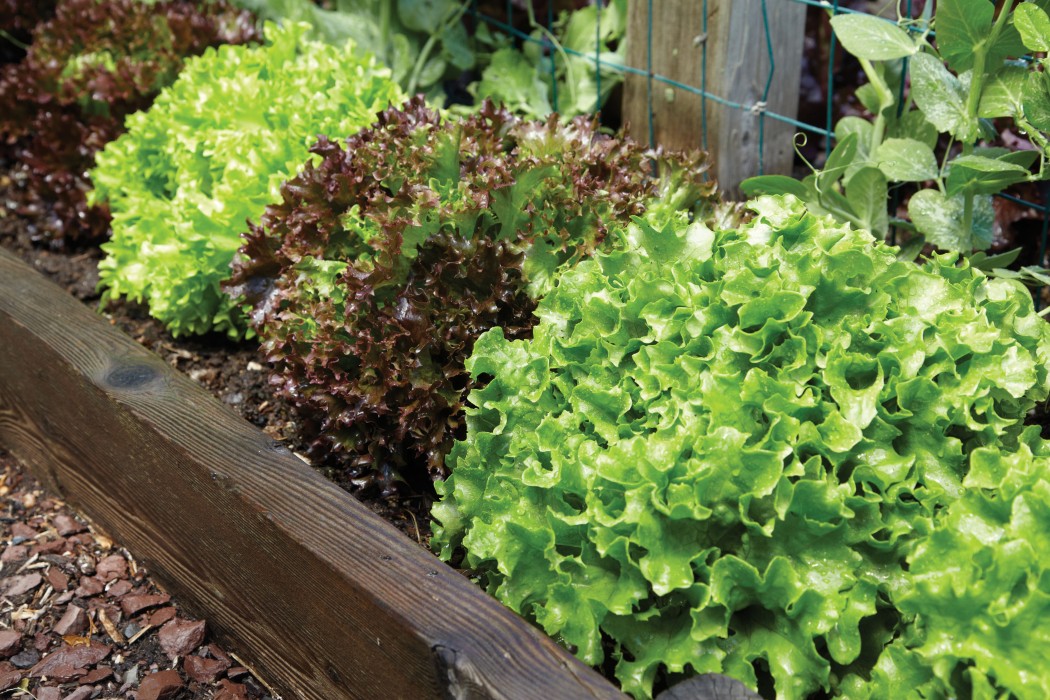Prime planting time for spring lettuce runs from March into early April, and it is also when gardeners tend to spread two misconceptions about this tasty, leafy vegetable: (1) Real lettuce is round and green, and (2) it is always planted in the veggie patch.
The familiar, rounded crisphead (also called iceberg) lettuce can be grown in area gardens, but why not go with a lettuce that is easier to grow and faster to mature that also and has more vitamins and better flavor? Try loose leaf lettuce.
There are many loose leaf varieties suitable for gardens in our region. The old standby is ‘Black Seeded Simpson’, but ‘Grand Rapids’ and ‘Salad Bowl’ have been dependable growers, too. Also, ‘Nevada’ and ‘Green Ice’ are varieties with excellent heat-resistant qualities that can stretch their harvests deep into the spring.
However, don’t think of loose leaf lettuce as a one-dimensional plant suitable only for the vegetable garden. Some varieties are as ornamental as they are edible — even fancy enough to add eye-catching appeal to flower borders, ornamental beds and container plantings. ‘Oak Leaf’ is a handsome example with its deeply lobed, pointed, dark green, oak leaf-like foliage. Prefer frilly instead? ‘Flying Saucer’ is an earthly delight of curled, crinkly leaves packed tightly together in small, rounded green mounds.
And if your landscape is awash in spring green, relief in red can be found with such loose leaf varieties as the ‘Red Sails,’ which can light up a plant border with its deep red to bronze leaves that are as tasty as they are pretty. ‘Lollo Rosso’ is a similar dazzler, with its highly frilled, crimson leaves. Ditto for ‘Red Salad Bowl,’ a real showoff flaunting deeply cut, burgundy leaves that darken in color with maturity.
Any loose leaf lettuce variety can be mixed into a spring ornamental planting site for an unusual twist, but one precaution must be taken. If you use fungicides or insecticides on your flowers and perennials, read the label carefully to make sure the chemicals are cleared for consumables. If not, either switch to safe controls or just enjoy the lettuce for its looks.
Many varieties of loose leaf lettuce can be bought in the spring as starter plants or seeds from local garden centers, but if you can’t find a certain selection, check these online sources:
Burpee: burpee.com
Cooks Garden:cooksgarden.com
Park Seed: parkseed.com
The growing site for loose leaf lettuce should be well-worked and free draining, as soggy soil can cause leaf rot on young plants. If you are inclined to go organic, compost mixed into the soil with a fish emulsion chaser should get the seeds off to a strong start. Otherwise, a sprinkling of ordinary 10-10-10 or 8-8-8 fertilizer will take care of the plants’ nutrient needs.
Thinly spread seeds across the prepared soil, and cover them with a quarter-inch of fine soil — no more, because light is very important for proper germination. If you insist on piling on the dirt, it will be more like a burial than a planting.
The seeds normally sprout in about a week. From here until the final harvest, Growing Rule No. 1 is DON’T FORGET TO WATER! Lettuce needs to be watered once or twice a week, especially during sustained dry spells, or the result will be slow growth and bitter leaves.
After the young plants develop their second pair of leaves, thin them to about 6 to 8 inches apart. Most loose leaf varieties will mature in about 45 days, but after the plants are 4 to 5 inches tall, if they are more for edible rather than ornamental purposes, and you have a craving for this green (or red) treat, snip off some of the outer leaves and enjoy.
Properly maintained, a 100-square-foot loose leaf lettuce bed or border will yield about 20 to 40 pounds of crispy crunch. But whether you eat it heartily or just look at it, loose leaf lettuce will be an appealing addition to any spring garden.
L.A. Jackson is the former editor of Carolina Gardener magazine. If you would like to ask him a question about your garden, go to his website at southeastgardening.com.







